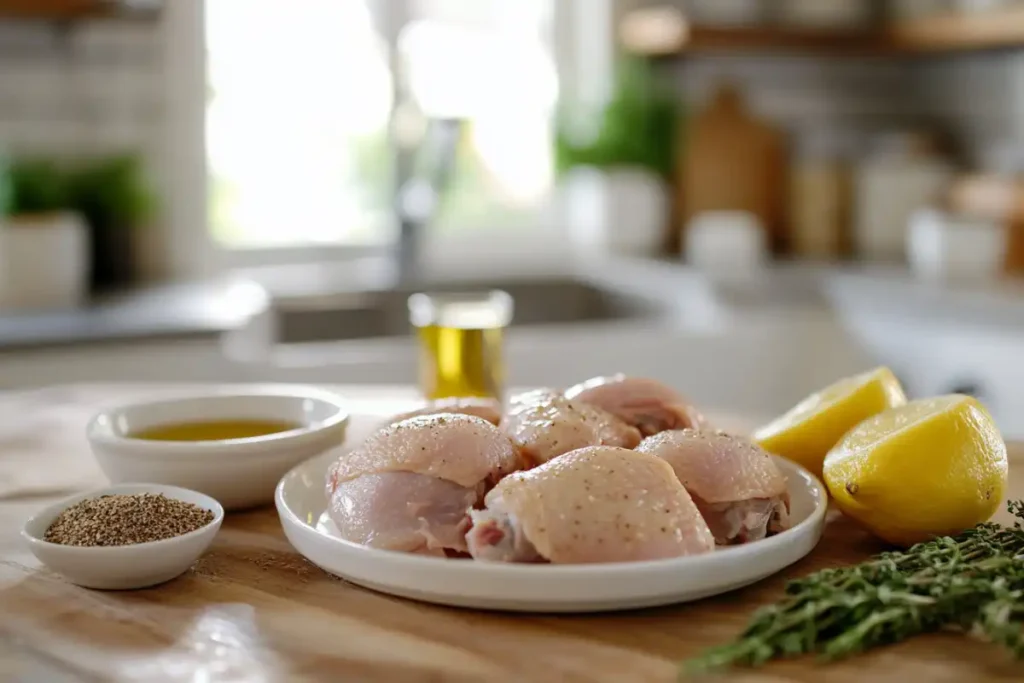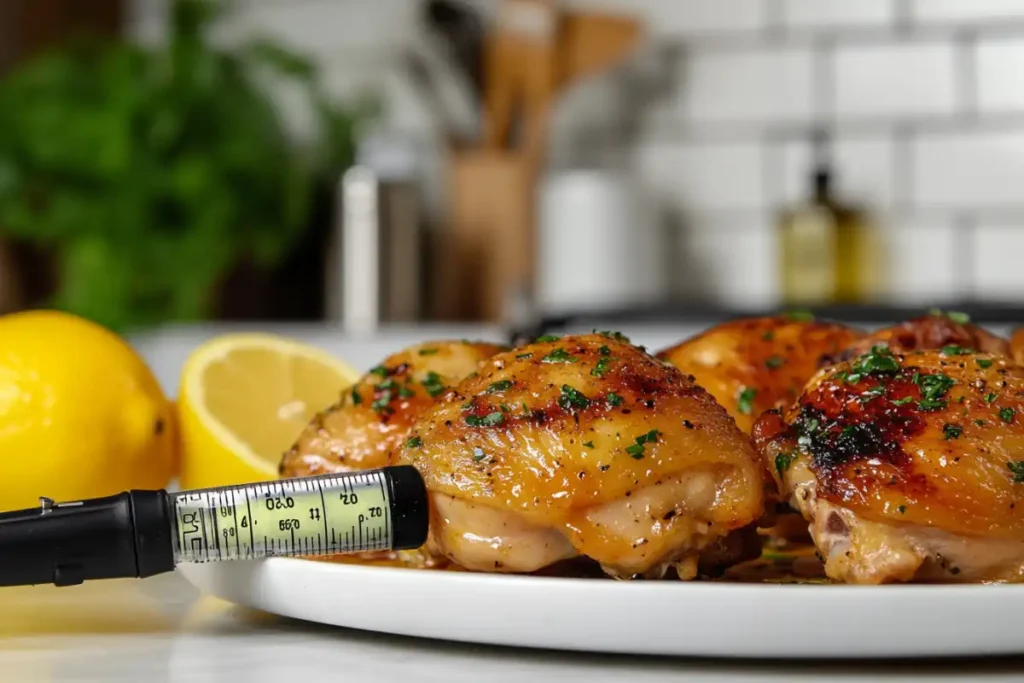Certainly! This article explores the safety of cooking chicken thighs at 145 degrees, offering key information and guidance. Let’s delve into the details to ensure your meals are both safe and delicious.
Understanding the Safe Temperature for Chicken
Cooking chicken thighs at 145 is a frequent question. However, food safety rules require the proper temperature for chicken. These rules are put in place to prevent foodborne illnesses. Therefore, knowing the right temperatures makes all the difference.
Why Temperature Matters
Temperature is essential for killing harmful bacteria. Chicken thighs and other poultry must reach a specific internal temperature. This critical step ensures the meat is safe to eat. Additionally, this temperature makes the meat palatable and enjoyable.
Official Guidelines for Chicken
The USDA recommends cooking all poultry to an internal temperature of 165°F (74°C). This ensures the destruction of dangerous bacteria, like salmonella. While cooking chicken thighs at 145 may seem tempting, it is not yet considered safe. Therefore, adhering to the 165°F is important.
Exploring Lower Temperatures and Food Safety
While 165°F is the recommended temperature, new research allows for lower temperatures under certain conditions. Therefore, cooking chicken thighs at 145 needs careful consideration. Let’s look at how to achieve this safely.
The Concept of “Holding Time”
“Holding time” refers to how long food stays at a certain temperature. The lower the temperature, the longer it needs to stay there. This concept is also known as pasteurization. Consequently, this method makes cooking chicken thighs at 145 possible.
Time and Temperature Combinations
For example, at 155°F (68°C), the chicken thighs need to stay at this temperature for around one minute to be safe. This method relies on maintaining the temperature accurately. However, it’s still not recommended for cooking chicken thighs at 145.
Risks of Undercooked Chicken
Eating undercooked chicken thighs can lead to food poisoning. Bacteria multiply rapidly in warm temperatures. Thus, consuming chicken that has not reached a safe temperature can cause illness. Therefore, it’s vital to cook the meat thoroughly.

Practical Tips for Cooking Chicken Thighs
Despite the complexities of lower-temperature cooking, you can still prepare safe and delicious chicken thighs. This requires careful monitoring and the right equipment. Here are some methods for cooking safely.
Using a Meat Thermometer
A meat thermometer is your best friend for food safety. Always use it to check the internal temperature of the chicken thighs. It’s the most reliable way to ensure the meat is cooked correctly. Consequently, this reduces the risk of foodborne illnesses.
Proper Cooking Methods
Whether you’re baking, frying, or grilling, ensure the chicken thighs reach the recommended internal temperature. Use techniques that allow for even heat distribution. This will help to reach the safety temperature uniformly.
Allowing for Carryover Cooking
The temperature of the chicken will continue to rise a bit after it’s removed from the heat. This is called “carryover cooking.” Take this into account when monitoring the meat’s temperature. It’s important to reach a safe temperature. However, don’t overcook. Therefore, monitoring is very important.
Ensuring Food Safety and Enjoyment
Keeping food safety in mind allows you to enjoy delicious chicken thighs. It is very important to use the right methods and equipment. This will help ensure your health and your meals are well-prepared.
Key Takeaways for Safety
The most important point is that chicken thighs must reach at least 165°F (74°C). Although cooking chicken thighs at 145 is possible with precise methods, it’s not recommended at home. Therefore, it’s better to be safe and reach the higher temperature.
The Importance of Thorough Cooking
Thorough cooking ensures that you get rid of harmful bacteria. Moreover, it also improves the flavor and texture of the chicken thighs. This means a more enjoyable meal for everyone. Thus, proper cooking is essential.
Avoiding Cross-Contamination
Always keep raw chicken separate from other foods. Use different cutting boards and utensils for raw and cooked items. Furthermore, always wash your hands after touching raw chicken. Consequently, this helps avoid the spread of bacteria.
How to Cook Chicken Thighs Perfectly
After covering safety, let’s focus on how to cook chicken thighs to perfection. There are a few methods that ensure the meat is flavorful and safe. Furthermore, these techniques are easy for home cooks.
Baking Chicken Thighs
Baking is a simple way to cook chicken thighs. Preheat your oven, season the chicken thighs, and bake until they reach 165°F (74°C). This method provides even cooking. This ensures the meat is juicy and tender. Baking chicken thighs also allows you to prepare other components of your meal simultaneously.
Grilling Chicken Thighs
Grilling adds great flavor to chicken thighs. Make sure the grill is hot. Cook the chicken thighs until they reach the safe temperature. However, watch carefully to avoid burning the outside. Thus, grilling requires patience. Grilling chicken thighs is a great option for outdoor gatherings, and it adds a smoky flavor that many people find appealing.
Pan-Frying Chicken Thighs
Pan-frying chicken thighs is a quick cooking option. Heat some oil in a pan. Then cook the chicken thighs on both sides until they are done. This method is excellent for when you are short on time. However, ensure you still reach the safe temperature of 165°F (74°C). Pan-frying chicken thighs is perfect for a quick weekday meal.
Slow Cooking Chicken Thighs
Slow cooking is another method that can yield incredibly tender chicken thighs. Add your seasoned chicken thighs to a slow cooker with your preferred broth and vegetables. The long cooking time breaks down the fibers making them easy to eat. Slow cooking chicken thighs is also excellent for meal prep.
Understanding Different Cuts of Chicken Thighs
When you’re working with chicken thighs, it’s helpful to know about the different cuts available. Each has its own characteristics, which may affect your cooking approach. Therefore, choosing the correct cut can make a difference in your final dish.
Bone-In, Skin-On Thighs
These are the most common type of chicken thighs. The bone adds flavor and keeps the meat moist during cooking. Additionally, the skin, when crispy, offers a tasty texture. Bone-in, skin-on chicken thighs are great for roasting, baking, or grilling.
Boneless, Skinless Thighs
Boneless, skinless chicken thighs are convenient for quick meals. They cook faster and are easy to cut and incorporate into various recipes. Furthermore, they are a good option if you are watching your calorie consumption.
Bone-In, Skinless Thighs
These chicken thighs offer the flavor of the bone, but without the extra fat from the skin. They are a suitable option if you want to reduce fat but still keep the taste. Therefore, this cut provides a good balance.

Marinating Chicken Thighs for Extra Flavor
Marinating is a good way to boost the flavor of your chicken thighs. A good marinade will add moisture and taste. Also, it helps the meat stay tender during cooking.
Basic Marinade Ingredients
A simple marinade can include oil, acid (like lemon juice or vinegar), and seasonings. Experiment with different combinations. Find the flavors that you like most. Therefore, marinades are a perfect way to personalize your dish. Basic marinade ingredients are versatile and can be tailored to your specific preferences.
Marinating Time
Marinate your chicken thighs for at least 30 minutes. For deeper flavor, marinate for a few hours or even overnight in the refrigerator. However, never marinate at room temperature. This will encourage the growth of bacteria. Thus, longer marinating time allows the flavors to penetrate the meat more deeply.
Ensuring Safety with Marinades
Always discard any marinade that has touched raw chicken. Furthermore, never use it as a sauce after the chicken has been cooked. Consequently, following these tips keeps your food safe. Also, discarding used marinade is a critical step to prevent any bacterial contamination.
Serving Suggestions and Pairings
Once your chicken thighs are cooked, it’s time to decide how to serve them. The right pairings can greatly enhance the dining experience. Therefore, thinking about this aspect is very important.
Sides that Complement Chicken
Consider serving chicken thighs with roasted vegetables, mashed potatoes, or a fresh salad. These sides help create a balanced meal. Also, they make your dining experience more enjoyable. Sides that compliment chicken can vary based on the main dish flavors.
Sauce Options
Pair your chicken thighs with your favorite sauces. Barbecue, honey mustard, or a creamy sauce work well. Thus, sauces add an extra layer of flavor to your meal. Sauce options provide various choices to improve taste and appeal.
Garnishes
A simple garnish can make all the difference. Sprinkling some fresh herbs like parsley or thyme elevates the dish. Therefore, small details can have a big impact. Fresh garnishes not only improve the presentation but also add a refreshing touch to the dish.
The Role of Seasoning in Enhancing Flavor
Besides marinades, using the right seasonings plays a vital role in enhancing the flavor of chicken thighs. Seasoning can significantly improve the taste of your dish. Therefore, exploring different seasonings is beneficial.
Basic Seasoning Blends
A simple blend of salt, pepper, garlic powder, and onion powder is a great start. These seasonings enhance the natural flavor of the chicken. Thus, basic seasoning blends are a good foundation for a tasty dish.
Using Herbs and Spices
Experiment with different herbs and spices like paprika, thyme, oregano, and rosemary. These can add unique flavor notes to your dish. Therefore, exploring various herbs and spices can provide exciting results. Using herbs and spices allows for unique flavor combinations.
Seasoning Before and After Cooking
Seasoning before cooking helps the flavors penetrate the meat, while seasoning after can enhance the taste. Therefore, a two-step seasoning process is effective.
Storing Leftover Chicken Thighs Safely
It’s common to have leftovers. It’s also essential to store them properly. This prevents bacterial growth. Therefore, knowing the best storage methods is important.
Cooling Down Leftovers
Allow your chicken thighs to cool down slightly before refrigerating. However, don’t leave them out at room temperature for more than two hours. This prevents bacterial growth. Subsequently, ensure you store them properly. Cooling down leftovers is a critical step for food safety.
Using Airtight Containers
Store your leftover chicken thighs in airtight containers. This keeps them fresher for longer. Additionally, it also prevents cross-contamination in the fridge. Thus, storing in the right container is important. Airtight containers are necessary to maintain the quality of leftovers.
How Long Leftovers Last
Consume leftover chicken thighs within three to four days. After that, the risk of bacterial contamination increases. Therefore, it is best to use them promptly. Using leftovers within a few days will keep your meal both safe and delicious.

Exploring Different Chicken Thigh Recipes
Now that you know the essential information about cooking chicken thighs, let’s explore some recipes that make the most of this versatile cut of meat. There are a plethora of options to keep your meals varied and enjoyable. Therefore, a variety of recipes are available for your liking.
Roasted Chicken Thighs with Root Vegetables
This is a simple, comforting meal. Roast chicken thighs with root vegetables like carrots, potatoes, and parsnips. The vegetables compliment the chicken beautifully.
Garlic Herb Chicken Thighs
Use a generous amount of garlic, herbs, and olive oil to create flavorful chicken thighs. This classic combination is always a crowd-pleaser. Garlic herb chicken thighs are a go-to dish for flavor lovers.
Honey Mustard Glazed Chicken Thighs
A sweet and savory glaze can elevate your chicken thighs. Combine honey, mustard, and a touch of soy sauce for a delicious and easy glaze. Honey mustard glazed chicken thighs are very popular and great for family meals.
Slow Cooker BBQ Chicken Thighs
For an easy meal, put your chicken thighs in the slow cooker with your favorite BBQ sauce. The low and slow cooking process will make the chicken extra tender. Slow cooker BBQ chicken thighs are a simple yet tasty dinner solution.
Mediterranean Style Chicken Thighs
Use olive oil, lemon juice, garlic, oregano, and tomatoes to create a refreshing Mediterranean style dish. Add some olives for a salty kick. Mediterranean style chicken thighs are a healthy and vibrant option.
Advanced Techniques for Cooking Chicken Thighs
For the culinary enthusiasts, there are a few advanced techniques to consider when cooking chicken thighs. These techniques will help you achieve the best results, so you can try them and explore new flavors.
Sous Vide Cooking
Sous vide is a method that involves cooking food in a water bath at a precise temperature. This method ensures the chicken thighs are evenly cooked and juicy. However, it requires specific equipment, but can be very helpful.
Spatchcocking
Spatchcocking involves removing the backbone of the chicken. This allows it to cook more evenly and quickly. It’s a great technique for grilling or roasting. Spatchcocking is also a nice way to present your chicken dish.
Brining
Brining involves soaking the chicken in a salt and water solution, with herbs and spices. This helps to make the chicken thighs more juicy and flavorful. Also, brining improves the tenderness of the meat.
Final Thoughts on Cooking Chicken Thighs
Cooking chicken thighs is a great way to enjoy a tasty and affordable meal. However, food safety should always be your priority. Therefore, you should use the right methods and follow the temperature guidelines to ensure that your chicken is safe to eat. Additionally, explore various flavors to keep your meals exciting. Thus, cooking chicken thighs is both rewarding and enjoyable.

